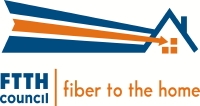
News
FTTH Council explores who gigabit internet subscribers are
September 13, 2012 | By Alyssa Dalton

September 13, 2012 – Early adopters of gigabit fiber optic service are online for three times the daily average of internet users and tend to have relatively complex home networks supporting five or more devices, according to a study released by the Fiber-to-the-Home (FTTH) Council Americas.
The Residential Gigabit Subscribers: Services, Applications and Attitudes report, provided to the Council by Telecom Thinktank and RVA LLC, offers a glimpse into the community of gigabit internet users who are receiving service from one of more than a dozen telecoms that now offer the service in locations throughout the world. Gigabit subscribers were surveyed to determine their motivation and utilization of the ultra-high speed broadband access.
Individual subscribers connected at gigabit speeds, or a thousand megabits per second, constitute a relatively new phenomenon, with the service having been first introduced by Hong Kong Broadband in 2010, noted the study.
“Since then, the number of telecoms offering gigabit service has been rapidly growing and includes mostly small-footprint operators serving densely populated areas and a few rural telecoms that are using their fiber infrastructure to attract new business and to bring their rural populations into the information age,” it said.
Most of the 2012 gigabit service offerings are symmetrical, with both upload and download clocking in at a full gigabit per second.
Among the global network operators, it is estimated that the total number of residential subscribers receiving gigabit service is still in the hundreds.
However, the report anticipates that the number will grow significantly over the next year as large gigabit-enabled FTTH services are rolled out in South Korea and Singapore, and by Google in Kansas City in the United States. RVA estimates that another 20 small, US-based FTTH providers, including municipal and competitive networks and some small local phone companies, are currently rolling out a gigabit service offering.
The user survey found the current crop of gigabit subscribers are:
• Online an average of 8 hours per day, compared with the U.S. internet user average of 2.5 hours per day.
• The “earliest of early adopters,” with relatively complex home networks consisting of five or more network devices.
• Content creators, as Hong Kong Broadband’s traffic measurements show its gigabit subscribers using three times the upload bandwidth when compared to their download use, where upload speed is critical for distributing HD photos and videos, efficient cloud computing and virtual presence video conferencing.
“Essentially, this study confirmed what one might expect, that those who subscribe to gigabit services have multiple applications in play at all times, including social networking, HD downloads, and streaming media via Netflix, Hulu and other sources, all while they participate in several multiplayer online games through multiple consoles,” said Heather Burnett Gold, president of the FTTH Council Americas.
“But what many people might not expect is that gigabit service is already available in a number of locations throughout the world, that more gigabit FTTH networks are presently coming online and that the number of gigabit subscribers is likely to grow significantly over the next couple of years,” she added.
The report found that most of the telecoms providing gigabit service are doing so to establish themselves as the undisputed market leaders in bandwidth and connectivity, and to enable them to offer ultra-low latency and bundle values to technophiles and high-bandwidth users requiring a large pipe to support multiple devices and services. Network operators also cited the appeal of superfast connectivity to work-at-home professionals requiring low latency and rapid file transfers.
Print this page